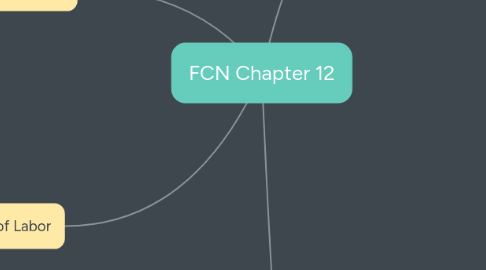
1. Teratogens
1.1. any factor, chemical, or physical that adversely affects the fetus
1.1.1. FACTORS: strength of teratogen, when fetus is exposed, teratogen's affinity for specific body tissues
1.1.2. MATERNAL INFECTIONS: teratogenic internal infection (viral, bacterial, protozoan
1.1.2.1. malaria, toxoplasmosis, rubella, herpes simplex, cytomegalo virus, syphilis
1.1.2.1.1. N/I: if pregnant, test must be done to see effects on fetus, herpes genital lesions, c-section is indicated
1.1.3. Virus/infections that can cause illness at birth
1.1.3.1. gonorrhea, candidiasis, chlamydia, strep B, hep B
1.1.3.1.1. N/I: antibiotics must be given for birth, longer stays in hospital for monitoring
1.1.4. Radiation, tobacco, alcohol, drugs, hypo/hyperthermia and herbs are all harmful to fetal development
1.2. N/I: Discuss workplace/residential environment changes that may be necessary, edu and info on drug detox/rehab programs, edu on infection prevention/prenatal care
2. Signs of Labor
2.1. uterine contractions
2.2. bloody show
2.3. ruptured membranes
3. Self care during pregnancy
3.1. bathing
3.1.1. sweating, vaginal discharge increase during pregnancy, assist with daily tubs/showers
3.1.2. N/I: no douching, no tampons for risk of infection, baths help take weight off back, not too hot of water, can't take bath further along in pregnancy if membranes have ruptured
3.2. breast care
3.2.1. N/I: instruct to wear supportive bra, teach to wash breasts with clean/clear tap water (no soap), at 16th week, colostrum begins. Education on what it's going to feel like, tingling is common (make sure to educate adolescents)
3.3. dental care
3.3.1. make sure brushing teeth, regular dentist visits, brushing teeth regularly, eating healthy/non-sugary snacks to prevent infection from becoming systemic and passing to fetus
3.4. clothing
3.4.1. avoid tight draw strings/waistbands, no knee high stocking b/c they impede lower extremity circulation, no heels; fall risk & extra pressure on spine, minimize pelvic tilt.
3.5. perineal
3.5.1. wipe front to back, avoid kidney infections UTIs because they can induce preterm labor, educate that douching is contraindicated b/c it increases risk of uterine infections. Edu that increased discharge is normal
4. Minor body changes
4.1. NURSING DX
4.1.1. health seeking behaviors r/t learning about minor body changes in early pregnancy such as morning nausea
4.1.1.1. Imbalanced Nutrition r/t less than body requirements or more than body requirements
4.1.1.1.1. Deficit Knowledge, Acute Pain,
4.2. Assessments
4.2.1. disturbed sleeping patterns, fatigue, muscle cramps, breast tenderness, constipation, dehydration, acute pain
4.3. Breast tenderness
4.3.1. one of the first signs of pregnancy, cold air irritates, for most women, its transient and minimal; not concerning unless lack of edu or infection
4.4. Nausea/vomiting/constipation/pyrosis (heart burn)
4.4.1. N/I: eat small, frequent meals, avoid spicy foods, avoid laying down for 2 hours after meal, increase fiber and fluids in diet, safe to Colace but not laxatives
4.5. Faitgue
4.5.1. make sure woman is sleeping on her side, not on her back to avoid hypotension
4.6. Muscle cramps
4.6.1. decreased serum calcium levels, increased serum phosphorous levels, interference with circulation
4.6.1.1. N/I: elevate legs 15 min every hour, eat calcium rich foods
4.7. Hypotension
4.7.1. occurs when woman lies on back and presses on inferior vena cava and impedes blood return to heart
4.7.1.1. N/I: prop pillows underneath top part of torso, lateral (side-lying) position
4.8. Veriscosities
4.8.1. from increased fluid and pressure volume, edu that this is normal and why it's happening
4.9. Hemorrhoids
4.9.1. from excess pressure on vagal nerves (straining while pooping)
4.9.1.1. N/I: increase fiber, causes decreased gastric motility
4.10. Heart palpitations
4.10.1. increased blood supply in body and need to circulate more blood
4.10.1.1. N/I: educate that this is a normal occurrence, not an issue unless blood pressure changes or SOA
4.11. Frequent urination
4.11.1. due to pressure on bladder from growing uterus
4.11.1.1. N/I: leaking may occur, may need to wear liners and change underwear frequently to prevent infection
4.12. Abdominal discomfort
4.12.1. due to stretching of abdominal muscles and perineal area in late term pregnancy
4.13. Leukorrhea
4.13.1. whitish vaginal discharge occurs in response to high estrogen levels and increased blood supply to vagina and cervix in pregnancy
4.13.1.1. N/I: change underwear often to prevent infection
4.14. Musculoskeletal discomfort
4.14.1. pressure on spine and lower extremidies
4.15. Ankle edema
4.15.1. increased blood volume, decreased mobility
4.15.1.1. N/I: check for ankle clonus
4.16. Braxton Hicks contractions
4.16.1. practice contractions for uterus
4.16.1.1. N/I: edu that it goes away while walking, should not be painful, shouldn't increase with continuation, they're irregular

